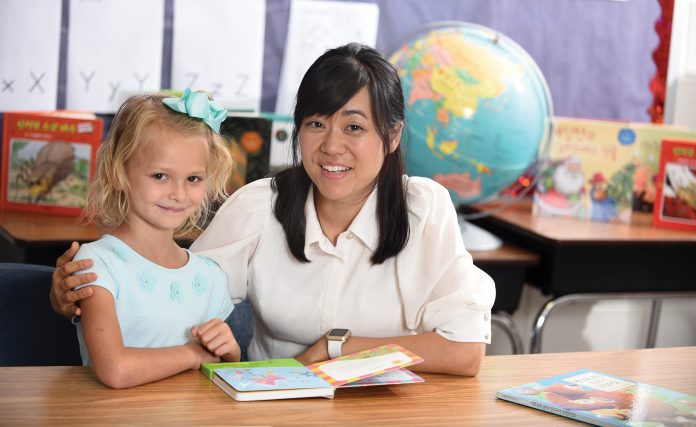Gwinnett County Public Schools embrace Korean language curriculum
Growing up, did you ever wish you could chat in a different language? Or if you’re a parent, have you ever wanted your child to be fluent in one? There’s probably no such thing (we think) as a magic genie, but learning a foreign language is a wish that’s been granted for many students in Gwinnett County—most recently, students of Parsons Elementary.
If you’ve ever visited this elementary school, tucked in the heart of Suwanee, you know it’s brimming with diversity. Turn the corner of the gleaming hallways and you’ll be greeted by students from a wide range of nationalities. So when the county announced that the school would be the next in line to adopt a foreign language, many parents were understandably thrilled.
But what exactly does that mean and how does it all work?
Something called The Dual Language Immersion (DLI) program makes it all possible. Don’t let the big words fool you—the program is a lot more friendly (and much less intimidating) than it sounds.
The Dual Language what?!
It might sound foreign (pun intended) to your ears, but the DLI program has been around a minute, and is the first national program to promote bilingualism in schools. In a nutshell, it’s a voluntary program that lets schools integrate a foreign language into students’ daily curriculum—if they want to participate.
Time warp back to the 70s and only a handful of schools had adopted DLI. But today, that growth has exploded, with over 2,000 schools now in the program across the U.S.
As one of Georgia’s top-ranked districts, Gwinnett County Public Schools (GCPS) embraced the DLI program in 2014, when it was first offered a chance to participate. Since then, nine of the county’s schools have adopted the program. Parsons will be the tenth in fall 2019 … and certainly not the last, if Dr. Jon Valentine, Director of Foreign Languages at GCPS, has any say in it. “Of course we’d love for all our schools to have this program,” he says. “It’s an opportunity like no other, ever.”
Breaking it down … in English
Have you ever sat through a foreign language class where the instructor spends the entire period purposely not uttering a word of English? That’s how the DLI program works…sort of. Students spend a portion of their school day receiving instruction in both English and a foreign language. GCPS, specifically, requires students to spend at least 50% of their day learning the Academic Knowledge and Skills (AKS) curriculum in the assigned foreign language.
At the start of the school year, students in the program will have a set of two teachers. One will be certified and fluent in Korean and speak only Korean. The other will be bilingual in both English and Korean but teach only in English and help bridge any learning gaps from the instruction students receive in Korean.
“The beauty of the program,” says Dr. Valentine, “Is that the curriculum never changes for the student. Just the language they learn it in does.”
Did someone say yeoboseyo?
How schools are selected to participate in the DLI program is surprisingly simple. It all starts with a board decision where members mull over potential options. Once a school is chosen, what language it’s assigned depends on things like community feedback but also how many well-qualified teachers speak the language.
Dr. Valentine says above all else, quality steals the limelight. “We never want to look at a parent and say, ‘We started this DLI program and had to find a teacher.’ We want to be able to look at them and say, ‘We found an excellent, excellent teacher who is certified, bilingual and an expert with AKS.’”
So far, Gwinnett schools have embraced languages like Spanish and French, but Parsons Elementary will be the first of the bunch to take on Korean.
How it’s going down…and rolling up
Sure, it’ll start at the Kindergarten level when it launches in fall 2019 at Parsons, but the DLI program will continue to add another grade level each year. Say for example a student enrolls in the program in Kindergarten. When they return to school the next year in first grade, the program will be added to that grade as well. This will continue every year, so on and so forth. At this rate, school officials hope, students will be confidently bilingual by the time they turn their tassels at high school graduation.
Getting your name in the pot
Hiring someone to teach your child a second language can cost hundreds or thousands of dollars over the course of their childhood, but in Gwinnett, the DLI programs are just part of the public school curriculum.
So how do you get in?
Before August, students zoned in the Parsons Elementary area will have first dibs on enrolling in the DLI program. If the demand exceeds what the program can handle, the school will have an in-zone lottery, so students who live within the school zone can be wait-listed as more spaces become available. But the best part is that even those who aren’t zoned to attend Parsons can join the program—that is, if there are any spots left!
Isn’t English enough?
Sure, great English skills can take you pretty far in life. But the benefits of adding words from a second language to your vocabulary carry both cognitive and economic benefits, according to GCPS leaders. “This will open doors for students toward bilingual careers in education, healthcare, sales and social and applied sciences,” says Dr. Valentine. “Anybody can learn a language, but this program maximizes on a tiny little point in brain development when children’s brains are especially perceptive to learning. That’s what makes it powerful.”





